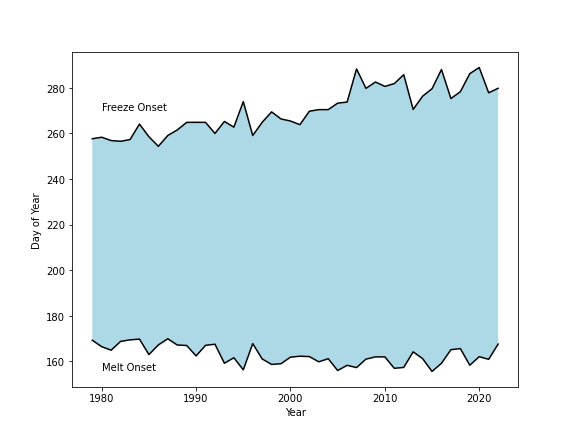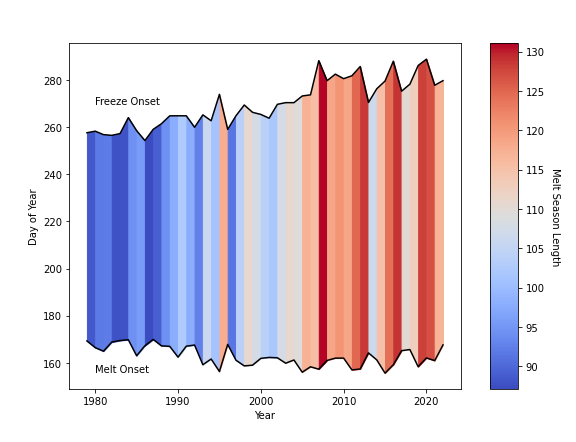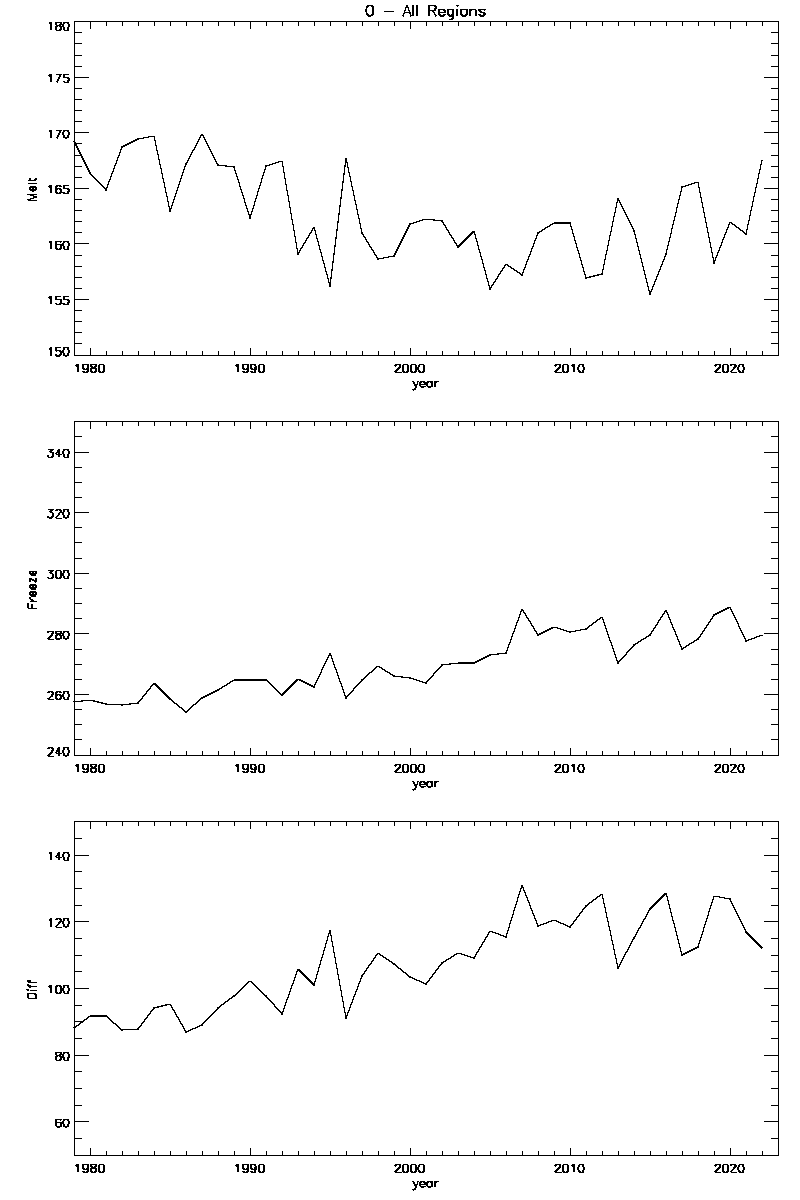Data Description
Yearly maps of early melt (earliest observed melt conditions), melt (melt conditions observed from this point until freeze), early freeze (earliest observed freeze conditions), and freeze (freeze conditions observed from this point on) for the surface of sea ice derived from SSM/I data. Reference:
Markus, T., J. C. Stroeve, and J. Miller (2009), Recent changes in Arctic sea ice melt onset, freezeup, and melt season length, J. Geophys. Res., 114, C12024, doi:10.1029/2009JC005436
Product Updated, 4/20/2023.
This update adds maps and data for 2022
Product Updated, 8/19/2022.
Added latitude/longitude fields to NetCDF products. Modified the sample python routine.
Product Updated, 2/17/2022.
This update adds melt maps for 2021.
Product Updated, 2/23/2021.
This update adds melt maps for 2020.
Product Updated, 12/14/2020.
This update resolved a subtle bug in the code due to IDL not preserving index order when sorting identical numbers. The averages and trends did not change significantly. The version number is now 731.
Product Updated, 9/16/2020.
This update adds melt maps for 2019. Changed contact info.
Product Updated, 3/07/2019
This update adds melt maps for 2018.
Product Updated, 2/26/2018
This update adds melt maps for 2017. Added NetCDF versions of the datafiles and a python routine to read them. Updated README.
Product Updated, 4/18/2017
This update adds melt maps for 2015 and 2016. 2016 uses F17 for the first part of the year and then switches to F18. The intercalibration between F17 and F18 looks good so at the moment no bias adjustment is done. We will continue to monitor the performance of F18.
Fixed a bug that didn't reinitialize the default freeze value between pixels which meant that in a low number of pixels there was no new freeze value determined and the algorithm used the prior result. This fix made the version 730s across all sensors.
Product Updated, 7/2/2015
In early October 2011, the AMSR-E instrument developed a fault and further data was unavailable on the archive. The previous source data for this routine, SSM/I F13, stopped providing data at the end of 2007 and at that time the routine had been adapted to AMSR-E and maps were processed from 2003 through 2010. The routine has now been adapted to use SSM/IS F17 as a data source for microwave brightness temperatures with the version “701s”, and the 2011 maps were processed.
In February 2014, we investigated anomalous behavior of the routine in coastal areas on the early freeze and freeze maps. We discovered that the bias correction used for F17 was misreporting ice concentration values during the melt period, and that was resulting in the poor freeze-up values. The bias was adjusted and the datset was reprocessed for 2007 on with version "702s".
The following figure shows average melt onset, freeze onset, and average melt duration in days for the entire Arctic.
These figures show the trends above on a single plot, with the space between the curves (the melt season length) in just blue and in a colormap to show the trend in melt season length due to warming.


Data Format
Readme for melt / freeze products
FLAT BINARY:
4 files:
- YYYYVVVVearlymelt.int.304.448.c - earliest observed melt
- YYYYVVVVmelt.int.304.448.c - permanent melt, should be melt conditions always after this
- YYYYVVVVfreeze.int.304.448.c - earliest observed freeze
- YYYYVVVVlatefreeze.int.304.448.c - permanent freeze, should be all freeze conditions after this
YYYY - year
VVVV - version, current set is 731s.
Integer arrays, 304 x 448, big endian (windows and mac will need to byteswap). Values are the day of year where the event described in the filename occurs (in 'melt', a value of 175 means melt conditions are present on June 24 in a non-leap year).
NETCDF:
1 file per year:
YYYYVVVVmeltfreeze.nc
YYYY - year
VVVV - version, currently 731s.
Six datafields: earlymelt, melt, earlyfreeze, freeze, latitude, longitude
There is a sample routine on our site called ncdftest.py that reads and plots the data.
Data Flags:
- -3
- land
- 0
- open water
- 75-410
- valid data
All negative values represent pixels where melt or freeze could not be determined; the different negative values correspond to different criteria in the algorithm and should not be considered for analysis. The earliest melt possible due to the algorithm is day 75. Data is no longer masked for the polar "hole" in the coverage, and users should note that the hole changes size with satellite transitions.
Regional Summary Files:
XXXX_regional_values_YYYYMMDD.txt
XXXX - product (early melt | melt | freeze | late freeze | inner diff (freeze - melt) | freeze anomaly)
These are text tables that give the average value per year (rows) of the named product per region. There has been some quality control on the pixels included in the averages. The first row gives the column labels, which are:
col - region code - region
0 - YYYY - Year
1 - 2 - Sea of Oktosk
2 - 3 - Bering Sea
3 - 4 - Hudson Bay
4 - 6 - Baffin Bay
6 - 7 - Greenland Sea
7 - 8 - Barent Sea
8 - 9 - Kara Sea
9 - 10 - Laptev Sea
10 - 11 - E. Siberian Sea
11 - 12 - Chukchi Sea
12 - 13 - Beaufort Sea
13 - 14 - Canadian Archipelago
14 - 15 - Central Arctic
15 - 0 - Entire Arctic (all the above regions)
Updated on 7/02/2015
Removed the AMSR-E products from this distribution in favor of SSM/I / SMMR trend only, since AMSR-E stopped providing data. Updated 2007+ to improved bias adjustment, version 702s.
Updated on 4/18/2017
Updated through 2016. Version changed to 730s across all the instruments as a bug in the default ice freeze value for some cases was corrected.
Contact info:
- Linette Boisvert, 301-614-5710
- Jeff Miller, 301-614-6611
README last updated 12/14/2020
Data Files
- ncdftest.py - py, 1.82 kB: Python 3 routine that shows how to read and plot the data.
